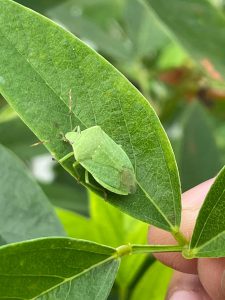The weather in Florida is adequate for many organisms to thrive. Unfortunately, this also includes many pest species that can harm crops and Ornamental plants. A pest can be any insect, mite, weed, fungi, bacteria, virus, bird, or any other organism that negatively affects the plants. To protect our plants and avoid potential problems, farmers and landscape professionals need to develop their own Integrated Pest Management (IPM).

Integrated Pest Management (IPM)
Having an Integrated Pest Management (IPM) program is essential to all agricultural establishments or maintaining any landscape. An IPM Program is a combination of all practices and methods needed to control pest problems. The IPM objective is to reduce pest management expenses, conserve energy, and reduce the risk of pesticide exposure to people, animals, and the environment while effectively controlling the pest problem. There are 5 steps in any successful IPM:
- Identifying the key pest – The key pest is the pest that causes damage to your plants regularly. Proper identification is essential for proper control. For example: both insects and mites are arthropods, but mites are not insects. To control a mite, you will need to use a miticide or a broad-spectrum pesticide that controls both mites and insects. If you identify a mite as an insect and use an insecticide, proper control will not be achieved. For a list of pests found in Florida click here.

Identification is the first step of any IPM program. This insect is a Southern Green Stink Bug (Nezara viridula). Photo credit to Jonael Bosques, UF/IFAS - Monitoring and scouting pests – Once the pest has been identified you will need to monitor it to determine if control is needed. For example: if the pest is in low populations and does not represent an actual threat to the plants control may not be needed. On the other hand, if the population is high and you are observing damage in your plants control may be needed. Farmer and landscape professionals should tolerate minor damages from pests, but when damage exceeds the economic threshold control will be needed.
- Follow control-action guidelines — These guidelines will help you decide how to avoid possible losses from pest damage. Answer the following question: how many pests and how much damage are acceptable or tolerated? Using these guidelines you can define your aesthetic injury level, treatment thresholds, and the timing of application.
- Prevent pest problems – It is always better to prevent pest problems rather than mitigate pest problems. Prevention will help reduce the use of pesticides which help the environment. To prevent pest problems, you can use pest-resistance cultivars, rotate the mode of action of the pesticides you use to avoid pesticide resistance, and any other method available that prevents the pest from reaching your farm or landscape such as barriers, traps, or preventive fungicides.
- Integrate different IPM practices —There are multiple methods available that can help you control pest problems:
- Cultural control – This method consists of proper selection (the right plant in the right place) and proper maintenance (mowing, pruning, fertilization, irrigation, and sanitation). Healthy plants withstand better pest problems so best management practices are important to avoid pest possible pest damage.
- Biological control – This method involves the use of natural enemies to control the pest. These natural

Spined Soldier Bug (Podisus maculiventris) a predatory Stink Bug is an example of biological control. Photo Credit UF/IFAS Extension enemies can be introduced into the farm and landscape or can be naturally occurring in Florida. An example of biological control are ladybugs, parasitic wasps, bigeyed bugs, minute pirate bugs, lacewings, and many others. For a list of Beneficial bugs click here.
- Mechanical and physical control – This method includes the use of machines, tools, or physical labor to reduce pests. The use of tractors and tilling machines, plowing a field, barriers, traps, and physically removing a pest are examples of mechanical control.

Yeast-sugar-water traps in Strawberry (A) and Blackberry (B) crops are examples of mechanical control. Photo credit to L. E. Iglesias, Department of Entomology and Nematology, University of Florida, Gainesville, FL. - Genetic control – This method consists of utilizing genetically superior plants that are more resistant to pest damage. Most of these plants are obtained by selective breeding. Root-knot nematode-resistant plants are an example of a preventive control method. Another example is citrus greening resistance oranges. These cultivars are not necessarily immune to diseases but will tolerate better the diseases presenting less damage.
- Chemical control – This method involves the use of pesticides to control the pest. Sometimes the use of pesticides is the most effective method for pest control but whenever using pesticides you must take into consideration the possibility of human exposure and environmental risk. Therefore, when using pesticides always follow label instructions, only use them when needed, be aware of your surroundings, and avoid pesticide resistance by rotating the mode of action constantly.

When using chemical control read the label before the application. Photo Credit: Tyler Jones, UF/IFAS
Conclusion
Having an IPM program is essential for any farm or landscape. Pest problems can cause serious damage to crops or ornamental plants if they are not controlled properly, creating significant economic losses. Developing an IPM program is an effective way of controlling pest problems and it will help you make the right decisions to minimize costs, risks to the environment, and save money.
If you want more information about Integrated Pest Management access these “Ask IFAS” publications:
“LANDSCAPE INTEGRATED PEST MANAGEMENT”
“URBAN PESTS AND PEST MANAGEMENT”
“DO-IT-YOURSELF INSECT PEST TRAPS”
University Of Florida is an Equal Opportunity Institution
 1
1




